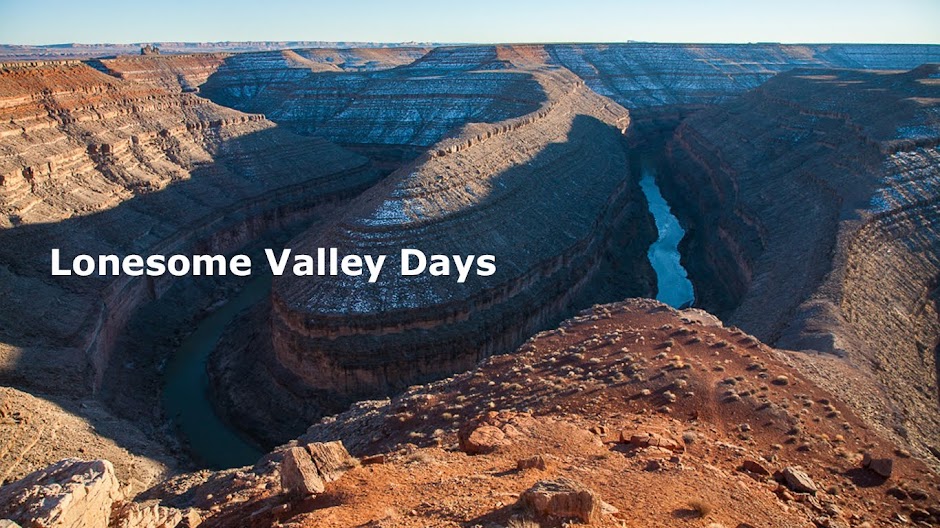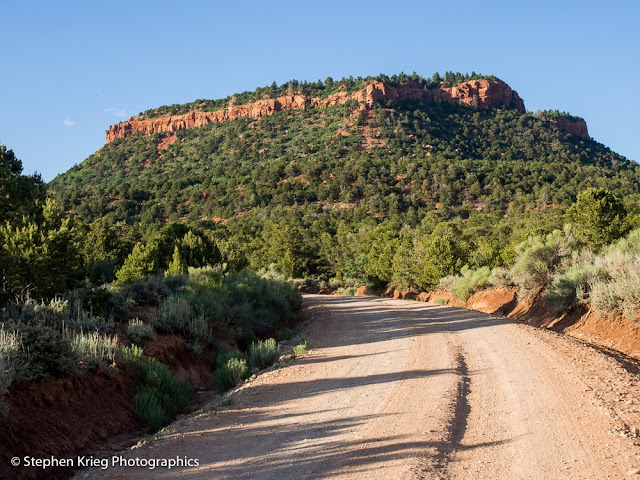 |
| Apex of the evening: Harvest Moon over White Mesa, from Cedar Mesa. |
|
It was the evening of the September Full Moon. The Harvest Moon, named back in pre-industrial days when the corn had to be cut and tied into shocks to finish drying, and the bright moon rising at dusk allowed the families to work the fields as late as they could stand it. Because it was their year's crop, their income, their everything, on winter's doorstep.
But this was 2016, not 1700s colonial America back East. The moon didn't care. It would rise true in its orbit regardless of who cared.
I cared. I watch for Full Moon time each month. For landscape photos. For the once in a month visual and visceral experience. Weather permitting, you know, so some months are clouded out even here in the high and dry and lovely mostly clear skies of the desert Southwest.
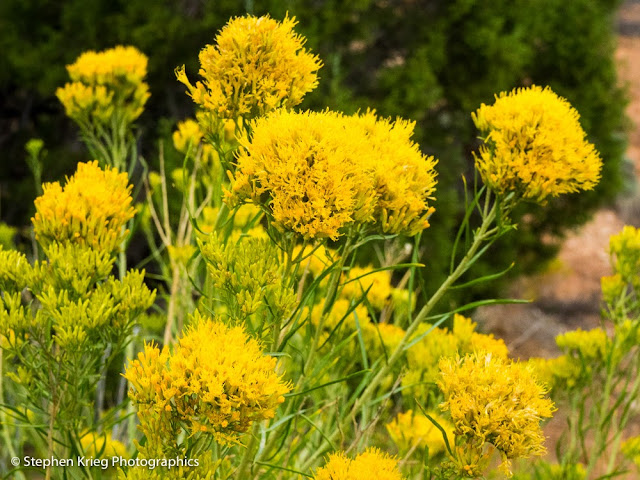 |
| Rabbitbrush in bloom, September, San Juan County, Utah. |
This time I was scheming for a different kind of photograph. One featuring the rubble of an ancient tower ruin on Cedar Mesa in southeast Utah. If I could line it up with the rising moon at dusk, that could be so cool. There was only one way to find out.
So I drove out to a ruin that is known locally and in certain guide books as Cave Towers Ruin. It's on public land, but it's unmarked from the highway, so you have to know how to get there. Open the gate, close the gate behind you, and drive on in. Unless you have a high clearance vehicle (AWD, like a Subaru) you should stop at the new (courtesy of Friends Of Cedar Mesa) buck-and-pole wooden fence and walk the rest of the way. It's not far.
 |
| West tower ruin at Cave Towers. |
Cave Towers? What kind of name is that? Isn't that an oxymoron? Is it in a cave, or is it towering above the landscape? It can't be both, can it?
Well, why not? Towers above the cave? A recess (overhanging) cave in the sandstone layers, with cliff dwellings below and brazen towers above on the canyon rim. Not a subterranean cavern.
 |
| Late day sunlight just below the rim on cliff dwellings rubble. |
Now it's making more sense. For the Ancestral Puebloans of 800 years ago, a reliable water source was a strategic scarcity to be defended for the livelihood of the community. Building a two story tower out of shaped sandstone slabs and adobe mortar announced to anybody approaching that "we live here, respect us or suffer the consequences". It is also suspected that such towers were used to build signal fires. A communication network across vast distances. Fire light, after all, is speed of light messaging. All is well. Or: enemies approaching, spread the alarm.
 |
| Cliff dwellings below the rim, underneath the towers. How to get down there? |
Don't ask how I got off on all of that. Obviously there was a lot more on my mind as I walked in to the rubble of the several towers that were in this one spot. This lip of a side canyon of Mule Canyon, with its spring below. Even an historic gravesite fenced off with a small slab of sandstone for a tombstone. (Things are always surprising in Canyon Country).
 |
| Peering into the canyon below Cave Towers Ruin. Sleeping Ute Mountain on the far horizon. |
Yes, I was thinking of the Ancient Ones as I again visited this sacred spot. The mid-September sun was already low, sliding quickly toward sunset. I arrived at my favorite tower ruin, the most prominent one, and got out my compass. Using The Photographer's Ephemeris app, I knew that the full moon would rise almost due East. It was already swinging back north from its southeasterly position at midsummer.
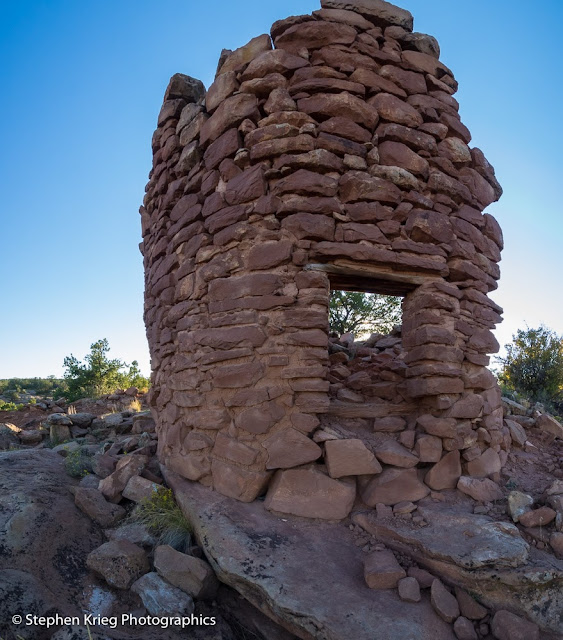 |
| The west tower and its entry doorway, from below. |
I worked around the site, but it soon become obvious that I could not get the moonrise in a good composition with the tower ruin this time. Maybe October. So I photographed the tower rubble and its environs and quickly walked back out to the truck. There might still be time to find a better location for moonrise, without any ruins. Though on the walk out I could not help but to photograph a lovely clump of bright yellow wildflowers.
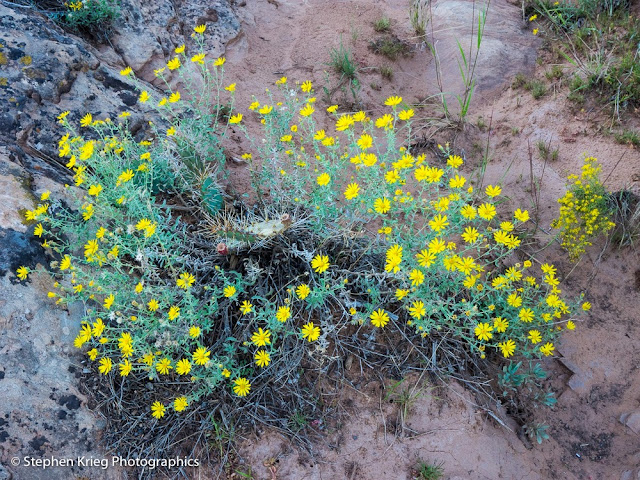 |
| Yellow wildflowers, some of the last of the season. |
Climbing back westward up Highway 95, I decided to make my last stand (of the evening) at Salvation Point, elevation 7,110 feet. A wide open clear view to the east.
 |
| The Earth's Shadow, and Sleeping Ute Mountain, just after sunset, from Salvation Point. |
The sun set behind me as I continued to stare east. The Earth's shadow grew blue, with the pink Venus Belt fringing it at the top. Sleeping Ute Mountain lay stretched out, a lumpy and slightly darker blue across the state line in Colorado.
Waiting, waiting. Waiting for the moon to show. I knew it would be about 20 minutes after sunset this night.
 |
| Harvest Moon emergence, from Cedar Mesa. |
Then it began to peek through the blue. The upper yellow arc of the circle still hidden behind some clouds, or maybe even the La Plata mountain range in southwest Colorado. The haze on the horizon made it a deep yellow-orange orb slowly rising from the blue. Incredibly lovely. Almost orange as a pumpkin, fitting for the Harvest Moon in America.
 |
| Lord of the eastern horizon on this lovely September evening... |
Silently creeping up as the Earth rotated beneath my feet toward it.
A lonely highway in the middle of nowhere, so almost no traffic. Wide open skies. Moonrise. The high desert. September, the second best month of the year.
 |
| Panorama: Risen moon over White Mesa, from Cedar Mesa, Utah. |
It doesn't get much better than this.
Photo location: San Juan County, southeast Utah.
Prints and photo products are available on my Fine Art America sales website:
http://stephen-krieg.pixels.com/
© Copyright 2016 Stephen J. Krieg


